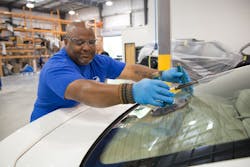Kirk Hicks was facing a decision he says many shop owners inevitably confront.
His business, Craft Collision Center, had just expanded to its second location in Lynchburg, Va., in early 2014, and he had plans to expand further. Hicks credited some of that growth to Guardian Auto Glass—a local glass repair operation that easily conformed to his production schedule.
But when Guardian was bought out by a larger company, a choppier communication process for subletting his glass work gradually increased Craft Collision’s cycle time by 1.5 days by the end of 2014.
And that’s when Hicks had to ask himself that imminent question:
Should I bring glass repair in-house?
“A lot of shop owners won’t do it because it’s hard to turn a profit,” he says. “For us, it was about making things more convenient. And if I could turn a profit too? It would be a win-win.”
Not only has establishing a glass unit at Craft Collision streamlined the glass repair process, but it has, indeed, turned into a profit center for the company, as well as a whole new mobile glass repair business for Hicks. In a year where he opened two more collision repair shops and set up a new glass repair facility, overall sales doubled to $10 million in 2015—$700,000 of which was credited to glass. And that cycle time increase? Gone. Cycle time dropped back to Hicks’ previous standard of 7.5 days.
The Background
For many years, Hicks’ body shop was never able to top $1 million in sales. But when Craft Automotive Group bought his business, it kept him on board as the shop operator and moved him into a larger building in 2005. He immediately experienced a surge in business. With sales eventually topping $2 million, he once again moved the business into a larger facility in 2014 and built up enough momentum to open a second shop.
Concurrent with Hicks’s success, Marie Crawford’s business was thriving, as well. As district manager for Guardian Auto Glass, she had formed profitable relationships with several local collision shops for sublet work, including Craft Collision.
But just as Hicks readied to open his new, second location, Guardian made a deal, as well. Following the glass company’s buyout, Crawford was demoted, and Hicks now was left to arrange his sublet glass work through a call center.
The Problem
With a middleman between Craft’s estimators and the mobile glass company’s technicians, scheduling became a huge hassle. Guardian’s staff would consistently be on-site the same day, while the new company held up production.
“It took way too much time for my estimators to be on the phone, trying to schedule glass work,” Hicks says. “And then it was never the same day, or ever the next day, they could get there to do repairs.
“On top of that, a lot of times they would come in there with the wrong piece of glass, making it take even longer.”
While only 5 percent of Craft’s workload involves windshield or glass replacement, Hicks relied on his glass repair company for standard inspection procedures, as well. “If we needed to pull the glass out to put a quarter panel in, or if we needed to pull the back glass out to do the roof, we were basically just sitting around waiting for them,” he says.
All of this combined to raise Craft’s cycle times by 1.5 days to almost nine days total.
It also led to Crawford officially joining Craft’s team. Fed up with the service environment, Crawford came on as Hicks’ assistant manager, and instantly began to work with him on starting his own glass repair unit.
The Options
Hicks had to decide between hiring his own glass team or choosing a new company with which to partner. But because of a lack of options locally, Hicks says he was stuck with the new glass company.
That made his partnership with Crawford all the more intriguing: She knew how to manage a glass shop and she could pull together a team of trained glass technicians equipped with the proper tools.
While an investment in glass can be substantial, Hicks saw an opportunity for minimal investment. He didn’t need to search for or train a glass team, he didn’t need to invest in glass repair tools, he could integrate the glass process into his CCC ONE management system, and because he had moved his original Craft Collision into a bigger building, he could move the new glass business into the vacant facility.
Hicks’ biggest investment would come from purchasing vans for a mobile glass unit. Luckily, once again, Crawford knew what would work best and worked with her techs to find a vans that could be outfitted with the proper tools.
The Solution
With three glass technicians scheduled to perform around seven mobile non-collision jobs per day, Crawford integrates their schedule into the management system and now blocks out time for glass removal, repair and reinstallation at the four Craft shops throughout the week.
“Estimators handle their own scheduling at the body shops,” she says. “If they need something removed tomorrow, they’ll call and tell us, and we’ll schedule the reinstall for the drop-off day. We keep track of it all on our own board.”
For the glass business itself, Hicks’ $250,000 investment involved three main parts:
The Building. Not only had Hicks opened a second location, but he had just moved his original shop into a larger facility—leaving a 5,000-square-foot building open for glass repair.
Although the building has four stalls for customers who bring their vehicles in for glass work, the building is mostly used to house parts and equipment.
The Staff. The team is made up of three mobile technicians, one customer service representative scheduling mobile glass repair visits, and Crawford, who works with estimators at each Craft location to set up glass appointments.
The Mobile Unit. The largest chunk of Hicks’s $250,000 investment came with purchasing vans for mobile glass repair, and outfitting each van with the proper equipment. Although his glass technicians already owned some of the tools and equipment, Hicks purchased the following:
- Inverters to power tools from the van
- Vacuums to suction air from the damaged area
- A glass rack
- Equalizer Express tools to remove glass
- Sika adhesive products for installing glass
- Various rivet guns for door glass
- Mirror wrenches
The Aftermath
Within six months, the glass shop had become profitable. Of the $700,000 in sales, only about $100,000 came from performing non-collision glass work at Craft facilities.
Over the course of 2015, a simpler scheduling processes allowed cycle time to drop from just under nine days back to around 7.5 days.
Hicks says the shop’s customer service has improved, and that Craft can now truly be a one-stop shop for repairs.
“Often, we would have a customer with a separate glass claim not related to the collision repair. We would have Guardian’s competitors come into our shop to want to replace this windshield while we had it on a separate claim,” he says. “This helps eliminate a lot of confusion there is with our customers.”
Also, as an extra bonus, the glass repair team offers an opportune way of marketing the business.
“It doesn’t hurt to have three vans running up and down the road with the Craft logo,” he says. “It’s a big moving billboard for us.”
In early 2016, Hicks opened his fifth collision center, putting the company at six facilities today.
The Takeaway
“It’s not a huge profitable operation for us,” Hicks says. “Very rarely would you hear a business owner say, ‘I’m glad to break even, or make a slight profit.’
“But it’s a win from the convenience point of view. We’re of the mindset, ‘If we can break even, raise the convenience factors for our customers, and make a little bit of money off of it, it’s a win.’”
Expert Advice: Keeping Up with Windshield Technology
—
In 2007, Joel Timmons started Profitable Glass Solutions Ltd., to help owners start glass operations at shops. Nine years later, he says many collision shops still don’t have a grasp on the opportunities glass presents. And in order to fully capitalize on glass repair, he says it’s important to note recent changes to windshield technology and how it affects your shop.
A collision shop enters auto glass for two reasons: one, to increase efficiency and productivity; and two, to increase the quality of service they’re delivering. The collision center, even when they subcontract work out, is assuming the liability for the quality of glass that is installed. You can subcontract the labor, but you can’t subcontract the risk. It’s in the collision center’s best interest to be informed of the type of glass being installed and to ensure that the vehicle is road worthy.
Glass is incorporating more and more technology, such as the lane departure cameras, rain sensor cameras. The amount of technology that is influenced by glass is extraordinary. A windshield is no longer just an optimal device—it’s a way for a manufacturer to incorporate more safety features that enable the operator to drive the car more efficiently and more safely. It’s going to be more and more standard on cars in the coming years.
Often, lane departure systems have to be recalibrated or reset in order for them to operate properly. If you’re repairing a vehicle and you replace the windshield and you do not recalibrate the system, the car owner may leave without it being operative, and suddenly you’re liable. There’s an increased element of risk. Same goes with rain sensors: If you aren’t checking the module, or you install the wrong kind of glass, it won’t work properly and it’s costing you time and money.



